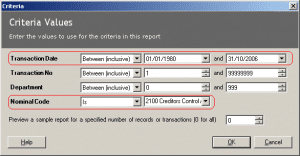Check for journals posted to the Creditors Control Account nominal code (3)
Check for journals posted to the Creditors Control Account nominal code (3)
1. Run the following report:
Nominal codes > Reports > Day books > Day Books: Nominal Ledger.
Sage Accounts 2014 (v20) and below – Modules > Nominal Ledger > Reports > Day books > Day Books: Nominal Ledger.
2. Enter the following criteria:
Transaction Date: Between (inclusive) – 01/01/1980 and the last day of the month being reconciled.
Nominal Code: Is 2100.
2100 is the default code for Creditors Control. You can check this in Settings > Control Accounts.
3. Check the totals for the Debit and Credit columns. If the values are the same, then journals are not the reason for the difference. If the values are different, subtract one from the other to give the difference.
If a journal is posted to the Creditors Control Account, it changes the value on the nominal code. However, the same value is not reflected anywhere in the supplier’s record, and as a result does not affect the aged creditors reports, resulting in the discrepancy.
Under normal circumstances, you should not post journals to the Creditors Control Account. The only time this should happen is when entering and reversing opening balances.
Difference
- If there is a difference, you must determine if the journals are correct or not.
- If they are correct, no further action is needed and there will always be a difference between the Aged Creditors and the Creditors Control Account because of the journal.
- If they are incorrect, the journal could be reversed or a further journal can be posted to move the discrepancy to a different nominal account.
If you are not sure if the journals are correct or not, please refer to your accountant.
No difference
If there is no difference, it means that the journals posted to the control accounts are not causing the discrepancy.


